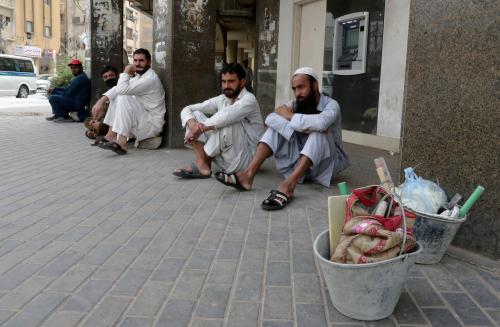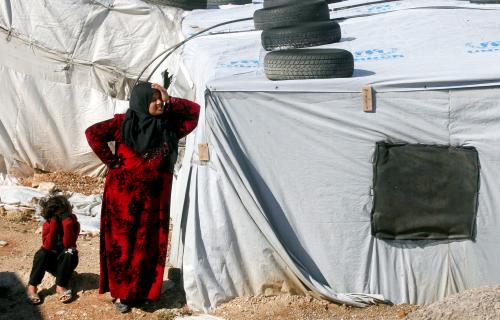The U.N. General Assembly recognized December 18 as International Migrants Day in 2000, 10 years after the 1990 adoption of the International Convention on the Protection of the Rights of All Migrant workers and Members of their Families. This year the day comes in the midst of a raging pandemic further challenging the world’s estimated 272 million migrants—a term that applies to all those who, legally or otherwise, have left their country for another. This number reflects a vast increase; the U.N. says a 2003 estimate foresaw only 230 million migrants by 2050. The U.N. expects these numbers to grow due to population growth, increasing connectivity, trade, rising inequality, demographic imbalances, climate change, and conflict.
The United States has the largest number of migrants at 50.7 million—around 15 percent of the population. Canada has 8 million, 21 percent of its population. Jordan, Lebanon, and the Gulf Cooperation Council states host 35 million international migrants, 23 million classified as migrant workers. They constitute a high proportion and often the majority of the population in Saudi Arabia (30 percent), Oman (45 percent), Bahrain (50.1 percent), Kuwait (70 percent), and over 80 percent in Qatar and the United Arab Emirates. In Belgium, migrants constitute 17 percent of the population; the corresponding numbers are 16 percent in Germany and 14 percent in the U.K. In terms of specific groups and going beyond first generation migrants, the European Union had 26 million Muslims in 2016, comprising 9 percent of France’s population, 8.1 percent in Sweden, 6.9 percent in Austria, and 6.1 percent in Germany.
Migrants are and will remain a very visible and indispensable part of life in many countries
These large numbers have had consequences. Especially in the West but also in Lebanon, Turkey, and elsewhere, politicians are using anti-immigrant rhetoric as political fodder. The U.N. says migration has been weaponized and used as a political tool to undermine democracy and inclusive civic engagement while downplaying migrants’ contributions. President Trump has instituted a ban on travel from Muslim-majority countries, reduced refugee resettlements from 96,000 in 2016 to 18,000 in 2019, and instituted harsh measures against asylum seekers. Anti-immigrant Brexiteers and populists from almost all EU countries need no introduction. The most telling of the mood in Europe was when the “migration, home affairs, and citizenship” portfolio at the European Commission was renamed as the office for “promoting our European way of life.”
Yet, migrants are and will remain a very visible and indispensable part of life in many countries. Their numbers, the critical work they perform, and the risks they face speak for themselves.
Two-thirds of migrants are labor migrants, accounting for 20.6 percent of all workers in North America and 18 percent in Western, Eastern, and Southern Europe. These workers are often in “essential critical infrastructure,” i.e., health, infrastructure, manufacturing, service, food, and safety. In the United States, nearly 70 percent of all migrants in the labor force work in these sectors. They also play a critical role in these sectors in large hosting regions like the Persian Gulf and Western Europe. The U.N. says, the U.S., France, Spain, U.K., Italy, Germany, Chile, and Belgium depend on the foreign born for health care. In the U.K. 33 percent of doctors and 22 percent of nurses are foreign born.
Migrant populations are most vulnerable to economic shocks like lockdowns and COVID-19 infections given their economic precarity and lack of adequate shelter and access to appropriate protective gear and health care.
Migrant populations are also most vulnerable to economic shocks like lockdowns and COVID-19 infections given their economic precarity and lack of adequate shelter and access to appropriate protective gear and health care. In Saudi Arabia, migrants comprised 75 percent of all new cases of the pandemic in May 2020. In June 2020, 95 percent of Singapore’s confirmed cases were migrants, mostly in dormitories. In New York, where 37 percent of the population is foreign born, migrants were overrepresented in 9 of 10 areas most affected by COVID-19.
However, their contributions go beyond performing the essential services avoided by locals. Migrant firms were the first to announce COVID-19 vaccinations. Underlining that immigrants have higher entrepreneurship and contribute disproportionally to innovation, Germany’s BioNTech, with employees from 60 countries was established by Ugur Sahin and Ozlem Tureci, children of Turkish migrants. Moderna has Lebanese-Armenian Noubar Afeyan as a co-founder. Moroccan born Moncef Slaoui heads America’s Operation Warp Speed to develop vaccines.
Women refugees are slightly less than half of all migrants, but their numbers are increasing faster while facing additional discrimination and mistreatment. Women are also most often the ones caring for the stricken whether at home or work with higher infection risks. The U.N. says their remittances skew more toward educational, health, and livelihood needs. Some 8.5 million women migrant domestic workers on insecure contracts face income loss and greater risks of abuse and exploitation, even as travel bans and border controls make returns impossible. For example, many of Lebanon’s 250,000 migrant domestic workers were abandoned by employers as the country’s economic crisis plus the pandemic and the port blast took their toll.
Among the most vulnerable are refugees, i.e., those displaced from their countries, mostly by conflict but also by economic crises, natural disasters, and climate change. Developing countries host 84 percent of all refugees. Over 50 percent of all refugees are from Syria (6.6 million), Venezuela (3.6 million), Afghanistan (2.7 million), and South Sudan (2.2 million). The top three hosts were Turkey (3.6 million), Colombia (1.8 million), and Pakistan (1.4 million). As a share of population, Lebanon leads with 156 refugees per 1,000; Jordan follows with 72 per 1,000. The pandemic has much worsened an already problematic health care situation.
The economic impact of migration is enormous and globally, 800 million people—1 in 9—receive remittances. In 2019 remittances to low- and middle-income countries ($548 billion) outpaced foreign direct investment ($532 billion) and official aid ($166 billion). The World Bank projects a drop to $508 billion in 2020 and $470 billion in 2021. The top three remittance senders in 2018 were the U.S. ($68 billion), the UAE ($44.4 billion), and Saudi Arabia ($36.1 billion). The top three destinations were India ($78.6 billion), China ($67.4 billion), and Mexico ($35.7 billion). Foreign direct investment ($532 billion in 2019) is projected to decline by 32 percent in 2020. Migrants send home, on average, 15 percent of what they earn, the rest is spent in-country.
Let us use International Migrants Day in 2020 to reaffirm the value of migrants and protect them so that they are part of “building back better.”
While migration may be temporarily slowed by the pandemic and populist politicians, it is not going to go away and will rebound. However, we do need to and are moving toward better managing it. On December 18, 2018 the U.N. General Assembly endorsed the Global Compact for Safe, Orderly and Regular Migration, a nonbinding agreement adopted by 164 member states, and described by the U.N. as a “roadmap to prevent suffering and chaos.” The previous day, the U.N. General Assembly had affirmed the Global Compact on Refugees, a framework for more equitable responsibility-sharing on the refugee challenge. Both are comprehensive frameworks for which implementation will take time and progress will be slow, but with the climate change challenge at humanity’s doorstep, progress cannot be delayed for long. Let us use International Migrants Day in 2020 to reaffirm the value of migrants and protect them so that they are part of “building back better.”





Commentary
International Migrants Day and COVID-19
December 18, 2020